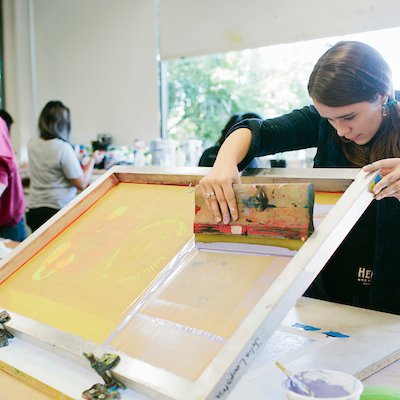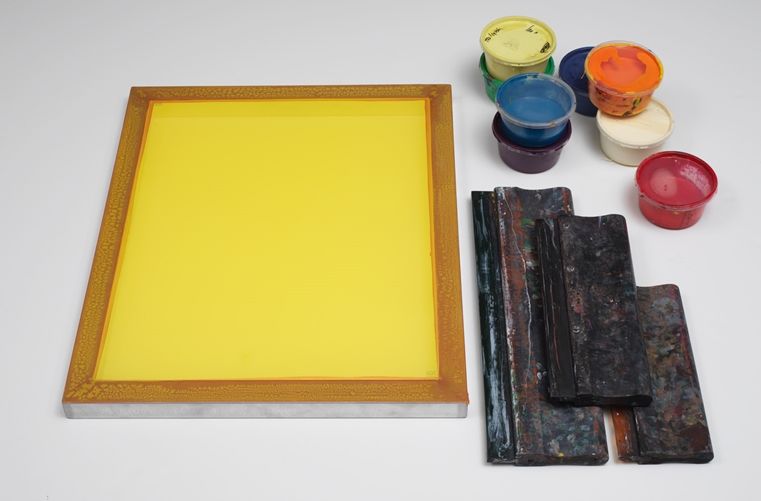ChatGPT said: Best ways to connect with 10:9 Design contact for service inquiries
Discover the Different Kinds Of Screen Printing Techniques for Your Next Job
Screen printing offers a diverse series of methods that can boost any type of creative job. From typical methods like serigraphy to contemporary technologies such as direct-to-garment printing, each technique has its unique advantages. Specialty choices, consisting of green and metallic inks, introduce a lot more possibilities. Understanding these methods can substantially influence the last end result. The obstacle lies in selecting the most suitable approach for particular needs and wanted results. What elements should one think about?

The Basics of Screen Printing
Although screen printing may appear facility, it is basically a simple process that entails moving ink via a mesh screen onto numerous surface areas. The method starts with the development of a pattern, which defines the layout to be published. This stencil is connected to a mesh screen, generally made from polyester or nylon. Once the stencil remains in location, ink is used to the screen and pushed via the mesh making use of a squeegee, causing the wanted pattern being published on the underlying product.
Screen printing can be carried out on a large variety of substratums, consisting of paper, material, and plastic, making it a versatile selection for different jobs. The process permits elaborate designs and vivid shades, making it popular in markets such as style, art, and advertising and marketing. Comprehending these essentials gears up individuals with the foundational understanding required to explore even more sophisticated strategies in screen printing.
Traditional Screen Printing Techniques
Traditional screen printing strategies have actually been employed for centuries, maintaining the craftsmanship and artistry of this approach. This technique makes use of a mesh screen to transfer ink onto a substratum, such as fabric or paper, allowing for vibrant and resilient designs. The process starts with producing a stencil, which blocks particular areas of the screen to manage where the ink will be applied.
One preferred technique is serigraphy, commonly used for minimal versions and artistic prints. One more is using water-based inks, which are green and give a soft feeling on textiles - 10:9 Design near me. Furthermore, traditional approaches can consist of hand-operated printing, where artisans use ink with a squeegee, making sure precision and interest to detail
These strategies remain valued in the industry for their tactile top quality and the special textures they produce, appealing to both developers and consumers that appreciate the heritage of screen printing.
Digital Screen Printing Innovations
As the demand for faster production and modification in the printing industry has actually surged, digital screen printing developments have actually become a game-changer. This innovation mixes traditional screen printing methods with digital processes, enabling rapid prototyping and detailed designs that were previously hard to attain. One considerable innovation is the introduction of direct-to-garment (DTG) printing, which facilitates top quality, full-color prints on various fabrics without the demand for displays. Furthermore, advancements in ink solutions have actually resulted in eco-friendly choices that keep vivid shades while minimizing environmental impact. The use of automated systems further streamlines production, reducing labor costs and boosting accuracy. These developments not just deal with tiny batch orders and individualized layouts yet also allow for quicker turnaround times, making them excellent for services focused on conference consumer demands in a fast-paced market. Digital screen printing, consequently, stands for a necessary advancement in the domain of printing techniques.
Specialty Screen Printing Techniques
Exploring specialized screen printing methods exposes a diverse array of methods that press the limits of imagination and functionality in the printing market. Amongst these, glow-in-the-dark inks offer a special aesthetic result, making layouts come alive in low-light conditions. Metallic inks, known for their sparkling finish, add a touch of high-end to printed materials. An additional innovative method is discharge printing, which eliminates color from the fabric as opposed to including ink, leading to a soft, vintage feeling. High-density printing develops an increased texture on the surface area, enhancing responsive engagement. Additionally, water-based inks are obtaining appeal for their vibrant colors and reduced environmental effect. Each of these specialized techniques deals with specific design demands, making it possible for artists and brands to produce standout products that resonate with their target markets. By leveraging these approaches, companies can boost their screen printing tasks to brand-new elevations, ensuring remarkable perceptions.
Eco-Friendly Screen Printing Options
Eco-friendly screen printing choices are gaining grip as the market moves in the direction of sustainability. Sustainable ink options and using eco-friendly products are key components in lowering the environmental influence of the printing process. By embracing these practices, screen printers can add to a more sustainable future while keeping top quality outcomes.
Lasting Ink Selections

Biodegradable Products Use
As the screen printing market develops, the consolidation of naturally degradable products is ending up being significantly crucial for environmentally conscious practices. Producers and developers are currently discovering inks and substratums made from natural, renewable resources that break down a lot more effectively than conventional equivalents. These biodegradable choices reduce plastic waste and minimize environmental impact, lining up with the expanding demand for sustainable products.
Usual instances include water-based inks and organic cotton materials, both of which lessen dangerous chemicals and advertise eco-friendliness. Brands that adopt these products frequently improve their market allure, drawing in customers who prioritize sustainability. As understanding of environmental issues remains to climb, the shift in the direction of biodegradable products in screen printing is most likely to obtain momentum, fostering a greener industry requirement.
Choosing the Right Method for Your Project
Exactly how can one determine one of the most suitable screen printing technique for a details job? The decision depends upon several variables, consisting of the product to be published on, the complexity of the layout, and the preferred manufacturing quantity - 10:9 Design Screen Printing Texas. Direct-to-garment printing is suitable for intricate layouts with many shades, while typical screen printing succeeds for larger runs of easier graphics.
In addition, factor to consider of the end-use of the published thing is crucial. For exterior applications, techniques that use durability and climate resistance, such as plastisol ink, may be preferred. Alternatively, environmentally-conscious projects may benefit from water-based inks or naturally degradable more info materials.
Ultimately, comprehending the task's special requirements enables an educated selection, ensuring both aesthetic allure and useful durability. By assessing layout intricacy, material compatibility, and manufacturing range, one can effectively select the most suitable screen printing technique to satisfy their job's goals.
Regularly Asked Inquiries
What Is the History of Screen Printing?
Screen printing stemmed in ancient China around 1000 AD, advancing through Japan and Europe. By the 20th century, it ended up being preferred in commercial art and style, revolutionizing exactly how layouts were created and dispersed worldwide.

Exactly how Do I Prepare Art Work for Screen Printing?
To prepare art work for screen printing, one should assure high resolution, use an appropriate color mode, produce different layers for each and every shade, and convert text to details, guaranteeing compatibility with the printing procedure and desired result.
What Materials Are Finest for Screen Printing?
The best products for screen printing consist of high-quality inks, durable displays, and appropriate substratums like cotton, polyester, or blends. In addition, using suitable solution and mops can enhance the printing process and final results.
Can I Screen Publish at Home?
Yes, screen printing in the house is possible. With the best materials, configuration, and techniques, individuals can produce top notch prints. Nonetheless, careful consideration of work space and equipment is necessary for effective results.
What Are Usual Errors in Screen Printing?
Common blunders in screen printing include improper exposure times, poor ink uniformity, imbalance of screens, not enough cleaning of products, and overlooking to evaluate prints. These errors can endanger the top quality and accuracy of the end product.
Screen printing may appear complex, it is fundamentally an uncomplicated procedure that entails moving ink through a mesh screen onto different surfaces. As the need for faster manufacturing and personalization in the printing industry has actually risen, digital screen printing advancements have arised as a game-changer. Discovering specialty screen printing methods discloses a varied selection of methods that push the borders of creativity and performance in the printing industry. The ideal materials for screen printing include top quality inks, resilient screens, and ideal substratums like cotton, polyester, or blends (10:9 Design Texas). Common mistakes in screen printing consist of improper direct exposure times, insufficient ink consistency, misalignment of displays, insufficient cleaning of products, and disregarding to test prints